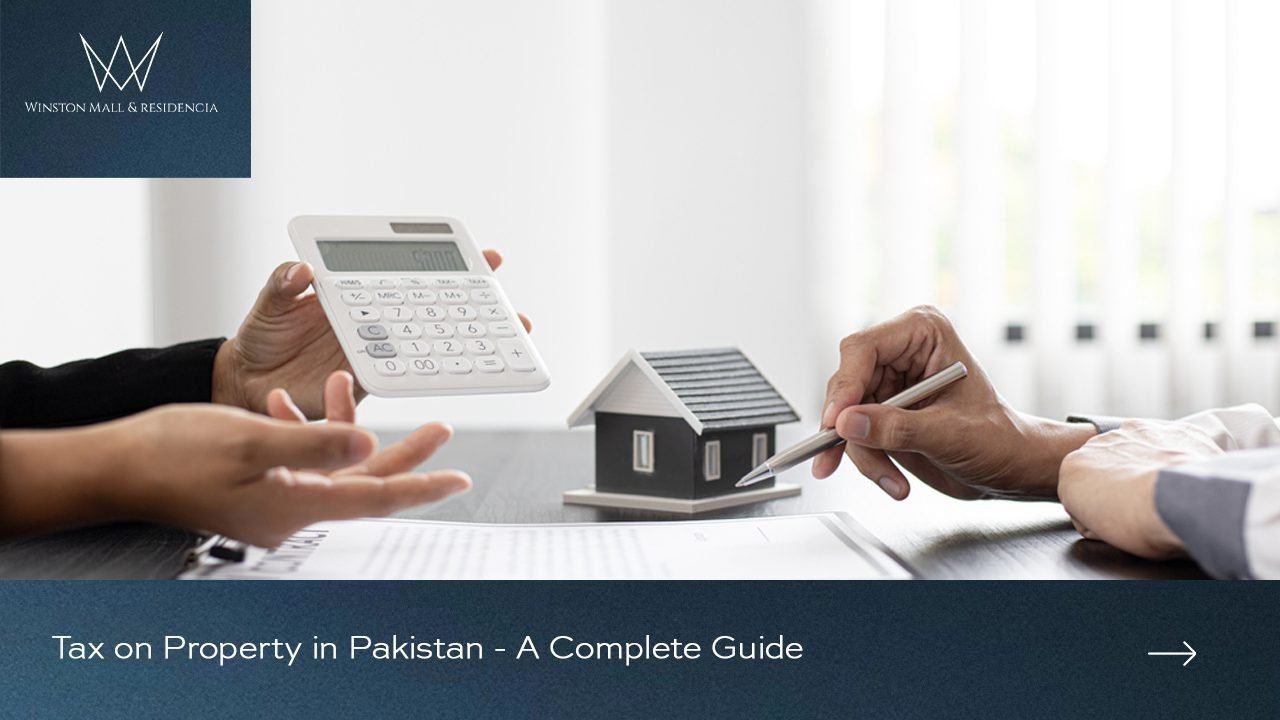The real estate sector stands as a cornerstone of economic activity in Pakistan, consistently ranking among the top sectors for investment and performance. This sector significantly contributes to the national GDP, notably due to its status as the most heavily taxed industry. Recent legislative changes, specifically in the latest budget, have introduced several modifications to property taxation.
In Pakistan, property taxes, as regulated by the Federal Board of Revenue (FBR), vary in structure and have substantial effects on the property market nationwide. This article will detail the property tax regulations included in the 2024-2025 budget, examine their implications for the real estate sector, and provide additional insights into this critical topic.
Table of Contents
ToggleWhat is FBR Property Tax?
The Federal Board of Revenue (FBR) in Pakistan is tasked with tax collection across the nation. Among these taxes, property tax plays a crucial role in the country’s fiscal strategy. FBR classifies individuals who are involved in property transactions into three distinct categories, based on their tax filing status. These categories play a key role in determining the amount of tax owed and the compliance requirements for each taxpayer. This classification not only streamlines the process but also impacts the real estate market significantly.
Filer
A ‘Filer’ is classified as an individual who regularly files their taxes and is listed on the Active Taxpayers List (ATL). Being a filer comes with certain perks, such as reduced tax rates on transactions and other financial benefits. Filers are seen as compliant with tax laws, and this status can significantly ease their financial transactions, particularly in the real estate sector. It is advisable for potential property buyers or sellers to ensure they are registered as filers to take advantage of these benefits.
Late-Filer
Late-Filers are those individuals who fail to submit their tax returns within the prescribed time frames, which typically include the months of July, August, and September. This category also includes those who do pay their taxes but do so after the due dates set by the government. Late-Filers may face various penalties, such as increased tax rates and additional fees, which can complicate their financial engagements. For those involved in property dealings, becoming a late-filer can result in higher transaction costs and reduced financial flexibility.
Non-Filer
Non-Filers are individuals who do not regularly submit their tax returns and are not included on the Active Taxpayers List (ATL). This group faces the most significant financial disadvantages, especially in the realm of property transactions. Non-Filers are subject to the highest rates of tax on property and other financial transactions, which can be prohibitively expensive. For individuals looking to engage in property transactions, it is highly recommended to rectify their status and become active filers to avoid these hefty charges.
By understanding these classifications and their implications, individuals engaged in property dealings can better navigate the complexities of the real estate market in Pakistan.
Types of Property Taxes in Pakistan
Before delving into the specifics of the updated property tax regulations set forth in the recent budget, it is crucial to familiarize oneself with the various types of taxes that are levied on properties in Pakistan. The main categories include Capital Gain Tax (CGT), Advance Property Tax or Withholding Tax, Federal Excise Duty (FED), and Capital Value Tax (CVT). Understanding these taxes is fundamental for anyone engaged in real estate transactions.
Capital Gain Tax (CGT)
Capital Gain Tax (CGT) is a tax on the profit earned from the sale of property, where the profit is the difference between the purchase price and the selling price. The 2024-2025 budget specifies that CGT rates will now apply uniformly, regardless of the holding period or the type of property (whether it’s a plot, constructed property, or flat). This marks a significant shift from previous years where the rates varied by these factors. For tax filers, the rate is set at 15%, while for non-filers, it can range from 15% to 45%, with the exact rate determined by the Federal Board of Revenue based on the property’s value. This fixed-rate approach aims to simplify the tax structure and ensure a steady revenue stream from real estate gains.
Advance Property Tax or Withholding Tax
Advance Property Tax, also known as Withholding Tax, is applicable at the point of sale or purchase of any property. This tax must be paid immediately when a purchaser receives the plot or property allocation. For the 2024-2025 fiscal year, the tax rates are structured to encourage timely filing. Filers face a lower tax rate ranging from 3% to 4% depending on the property’s value, whereas late filers and non-filers are subjected to significantly higher rates. This tiered approach is designed to incentivize compliance with tax laws and ensure that transactions in the real estate market are properly documented and taxed.
Federal Excise Duty (FED)
Introduced in this year’s budget, the Federal Excise Duty (FED) applies to the allotment or transfer of both commercial and residential properties. The rate is uniform at 5% for both types of properties. For residential properties, it’s important to note that this duty is charged only to the first owner upon allotment or transfer, reflecting an effort to regulate the primary real estate market and ensure that new developments contribute fairly to federal revenues.
Capital Value Tax (CVT)
Capital Value Tax (CVT) is imposed on the transfer or sale of immovable properties, such as houses, buildings, and plots. The rate of CVT for the fiscal year 2024-2025 has been standardized at 2% of the property value, as per the purchase agreement. This tax is generally the responsibility of the buyer and varies depending on the type of property and its valuation. The CVT is part of a broader strategy to regulate property transactions and ensure that they contribute to the national treasury.
Each of these taxes plays a critical role in structuring the real estate market, influencing both the behavior of investors and the revenue generation for the government. Understanding these can provide a solid foundation for making informed decisions in property investments and transactions.
How to Calculate Tax on Your Property?
Determining the tax liability for your property in Pakistan involves understanding the valuation methods used by local authorities. Each property, irrespective of its type, is valued according to the Deputy Commissioner’s (DC) rate, which varies from one district to another and is set annually by the provincial governments. These rates serve as a baseline for various taxes, including stamp duty and capital gains tax.
To accurately calculate your property tax, you should first obtain the latest DC rate list for the current year, which can typically be found on the official website of your district’s revenue department or at the local DC office. This rate list will provide the per-marla or per-square-yard value of properties within different areas of your district or tehsil, which is essential for calculating the tax due.
Step-by-Step Guide to Calculating Your Property Tax:
- Identify Your Property’s Category: Determine whether your property is residential, commercial, or agricultural as tax rates can vary based on property type.
- Obtain the DC Rate: Look up the current DC rate for your property’s location and category. This rate is the government-assessed value per unit area of properties in your locality.
- Calculate the Taxable Base: Multiply the area of your property (in marla, kanal, or square yards) by the DC rate per unit area to arrive at the taxable base.
- Apply the Tax Rate: Apply the appropriate tax rate to the taxable base. The rate could differ depending on whether the property is being bought, sold, or simply held, as well as on your status as a filer or non-filer of taxes with the Federal Board of Revenue (FBR).
Factors Influencing Property Tax Rates:
- Location: Properties in urban centers or commercially viable areas are usually subject to higher DC rates.
- Property Type: Commercial properties often attract higher tax rates compared to residential properties.
- Size: Larger properties incur more tax due to their higher valuation.
- Tax Filing Status: Tax filers often benefit from reduced tax rates in comparison to non-filers.
Understanding these elements and staying updated with the changes in tax laws are crucial for property owners. Regular updates from the provincial revenue authorities or consultation with a tax advisor might also help to manage your property tax commitments efficiently.
Impacts of Property Taxes 2024 on Housing Societies
The budget for 2024-2025 introduces specific property tax adjustments that promise significant implications for the real estate market in Pakistan. The structure of these taxes affects various segments of the market, particularly housing societies, which are pivotal in the urban landscape. These adjustments in property taxes are designed to regulate the market, streamline revenue collection, and potentially stabilize the housing sector. As stakeholders navigate these changes, the overarching impact could lead to a more transparent and robust real estate market, supporting long-term growth and sustainability.
Positive Outlook
Property taxes in Pakistan are calculated based on Deputy Commissioner (DC) rates, which are typically lower than actual market values or even the values assessed by the FBR. For example, in prestigious areas like Bahria Town and DHA, no residential property is officially valued over 50 million under DC rates, despite higher actual market prices. This discrepancy often results in lower tax liabilities for property transactions, providing a financial relief to both buyers and sellers. This method of calculation can foster a more dynamic real estate market by lowering the entry barriers for new investments and making property ownership slightly more accessible.
Downside of the Property Taxes
Reduced Market Demand
The introduction of increased withholding taxes in the property sector, particularly targeting non-filers, could lead to a notable decline in the number of real estate transactions. Non-filers might find the new tax regime prohibitive, leading to a slowdown in their investment activities. This hesitance can affect the liquidity in the real estate market, potentially leading to a stagnation or even a decrease in property values over time.
Impact on Property Prices
The recalibration of tax rates and the potential increase in transaction costs for property could deter sellers from entering the market, fearing reduced profit margins. This reluctance to sell unless at higher prices to offset the increased tax burden could lead to an artificial inflation in property prices initially, followed by a potential decrease as sellers struggle to find buyers willing to meet their elevated prices.
Altered Buying Intentions
Prospective buyers may become more selective, preferring transactions with tax-compliant parties to benefit from potentially lower tax rates. This shift in buyer preference could reshape market dynamics, where the emphasis on compliance could lead to a more structured but possibly less flexible market environment. Buyers’ tendency to favor dealings with filers over non-filers could marginalize a segment of the market, leading to a bifurcation in how real estate transactions are approached and finalized.
Conclusion
Taxation on property in Pakistan has ignited significant discussion about the future of the real estate sector, a critical engine of economic growth. Real estate not only contributes a significant portion of the nation’s revenue but also influences various economic facets from employment to investment opportunities. The recent modifications in property taxes introduced in the latest fiscal policies have dual implications for the market.
The imposition of new tax rates on properties can be viewed through various lenses. On one hand, these taxes are necessary for generating much-needed revenue for the country, helping fund infrastructure projects, educational advancements, and healthcare improvements. These funds are vital for the government to maintain and enhance public services, which in turn can lead to better living conditions and improved investor confidence in the real estate market.
On the other hand, increased taxation has its drawbacks, particularly for new investors and existing property owners. Higher taxes may lead to a reduction in investment, as the costs associated with purchasing and maintaining properties rise. This could slow down the real estate market, affecting everything from construction jobs to retail businesses that rely on new property developments.
Despite these challenges, the necessity for timely tax payments cannot be overstressed. Delayed or avoided tax payments result in surcharges, which further escalate the costs for property owners. It also hampers the government’s ability to plan and execute public welfare initiatives effectively. Therefore, it is essential for all stakeholders in the real estate market to remain compliant with tax regulations to ensure both their financial health and the economic stability of the country.




